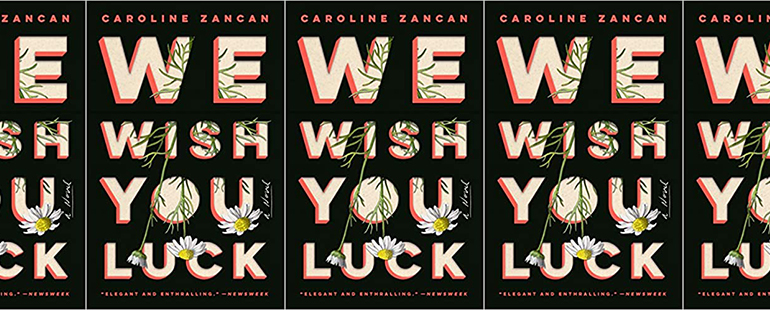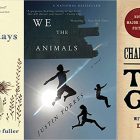We Wish You Luck’s Writerly Campus Novel

There is something thrilling about a good campus novel, the way its borders close around a defined perimeter and an alluring clique. These novels are almost always set on bucolic campuses with characters whose speech and mannerisms and clothing are as essential as the ways in which they judge and pursue each other. There’s a dangerous secret, and the stakes are high—the central threat is often death or expulsion, both of which, given the nature of these campuses, feels akin to expulsion from the Garden of Eden. In Caroline Zancan’s novel We Wish You Luck (2020), the setting is Fielding, a Vermont liberal arts college that offers one of the premier low-residency MFA programs in the country (notably, Zancan is a graduate of Vermont’s Bennington Writing Seminars, one of the premier low-residency MFA programs in the country). Fielding’s campus and the ten-day residencies that isolate the writers from the “Real World” push the campus novel into such an academic, writerly realm that the novel begins to take on the absurd.
The novel begins with a trick “Author’s Note,” a note not from Zancan herself but which positions the book as a story told by a chorus of voices, writers in the same cohort who bore witness to the novel’s central drama and who meticulously construct this story just as they do their fiction. “This might sound like a small detail,” they write, “but when you are in northern Vermont on a cloistered, remote campus for ten days, the weather is more than a detail.” This ominous sentence is akin to the famously bad opening sentence “It was a dark and stormy night,” so its inclusion establishes that this is a story that will be as ornate as their workshop pieces are pared of flabby prose. The note goes on to introduce the cast of characters as if we are playing Clue. The principle students are Leslie, who says she’s “an orphan whose parents were still alive, which only made about as much sense as most of the other things she said”; Hannah, “the embodiment of hospital corners”; and Jimmy, who “slept like a screaming baby heading openmouthed toward a nipple, or a runner sucking water down at the end of a long race.” Then there are the professors: Professor Sam Pearl, about whom the narrators say, “If the apocalypse hit, you’d want him around,” and Simone Babbot, who has “the cheekbones of a Tom Ford model and [who] had just moved in with the sort of New York restaurateur who usually dated them, or so [they] heard.” The degree to which each character is summed up into an action or physical feature mimics the specificity their program pushes, but these details are so over-the-top they turn hyperbolic. As a result, these characters and their plot feel both compellingly crafted and unreal—fitting, since their time on campus falls outside the bounds of the “Real World.”
The scene is thus set—a gorgeous campus of mercurial weather filled with the big personalities of celebrity novelists and their ambitious students who yearn for recognition. “There is no place where your life is less your own than at a gathering of writers,” the narrators write as they grapple for the perfect language, especially with which to describe the three writers who fascinate them most: Hannah, Leslie, and Jimmy, an aloof and enigmatic trio. At their first workshop, Leslie arrives late, then childishly writes Hannah’s name in colored pencil, which draws everyone’s attention when they’re supposed to be reading a short story. When Leslie gives Hannah her creation, Hannah firmly states, “You’re being rude,” and “[a]fter that, Leslie [was] completely in love. The kind of absolute, all-consuming love that distracts you from the tenets of life as basic as three meals a day, and conquers even the bleakest, most devastating strands of loneliness.” Their extremeness—Leslie’s childishness and Hannah’s singular focus—is striking, another narrative choice that heightens the story’s effect.
Jimmy, on the other hand, foils the schoolgirlish relationship between the two women, and he begins to feel unreal even before he becomes physically absent. “Jimmy was a different size and shape than any of us had ever known, leaving a cutout impossible to fill,” the narrators write. He grew up a ward of the state of Michigan, and now he’s so mute, unemotive, and small that he begins to feel like a flat character or, more precisely, like a character who has been flattened by how others remember him. Unintentionally hidden, Jimmy witnesses Simone’s despicable, racist, and classist outburst when she orders a Black bartender to serve her a glass of Chardonnay after 6:00 p.m. and he declines to serve her in accordance with Vermont’s liquor license rules. “Oh, Jesus, what is it with you people?” she spits, then adds, “Some people have jobs they care enough about to do more than the bare minimum, and you’d be surprised how time consuming that is.” Jimmy gives himself away by coughing, at which point Simone confronts him, saying, “I care less about our workshop schedule than why you’re skulking around down here, inserting yourself in conversations that have nothing to do with you when you should be up at dinner with everybody else.”
A newly minted superstar writer, Simone embodies not just snobbery, but the desire to infantilize those she perceives as below her, and Jimmy, already vulnerable and fragile, is easy prey. In workshop, Simone cruelly eviscerates Jimmy, despite the fact that his work is obviously superior to everyone else’s. “There are no true villains or heroes,” she says in response to another writer’s work; the statement is undeniably directed at Jimmy. “The villains in novels don’t know they’re the villains, or don’t think they are,” she continues:
Readers want the gray area and all the uncomfortable questions that live there . . . Sometimes the good guys do lose, or realize they weren’t as good as they thought they were. Sometimes the evil corporation wins the lawsuit . . . The Great Gatsby dies and the people who kill him go on with their lives as if nothing happened. And we know all too well what happens to poor Lenny.
This is the story the narrators construct, one with gray area, a villain who doesn’t know she’s a villain, and a character like poor Lenny situated in a plot that doesn’t end how the reader might want it to—just as they learned in workshop.
By the second residency, the narrators admit that “Hannah and Leslie had always been a source of intrigue, but across the January residency their pull grew into something more, from interest to fascination, and finally obsession.” Rather than the more mundane “pink,” Leslie’s silk slip party dress is “the color of a fresh head wound,” and later simply “gash-colored.” In another exaggerated simile, “Hannah’s laugh was like outdoor seating in front of sidewalk cafés on the first real day of spring—a call impossible to ignore.” But Jimmy, by that second residency, is dead. “The fact is that two months and four days before we were scheduled to return to campus for our second residency, Jimmy hanged himself with a scrap of old rope in his sometimes-father’s garage,” the narrators state. Surprisingly, the tragedy happens not within the bounds of the campus, but in the in-between time, when the campus and the campus novel are on pause. “[A]fter a few days of hushed cafeteria speculation, we silently, collectively decided that the best, only thing to do was to go back to telling stories the way we had been,” the narrators write. “Stories that, no matter how dire or depressing or tragic, had some sense of beauty or art to them, even if it was just an arresting image or moving line. Virtues that, as hard as we looked and as eager as we were to apply them, couldn’t be found in what Professor Pearl had told us that first morning.” Just as the tragedy has unfolded away from campus, the narrators’ writing abilities are tested; they must do more than what they’ve learned in the program. The tragedy of Jimmy’s suicide is a story they can only tell by pulling together their scraps of information into some sort of narrative arc. “We weren’t grief whores,” the narrators say, “we just knew that to write about anything really well you had to be able to picture it.” They’ve stitched this story together strategically not to be sensationalists, they explain, but just to tell the story well.
As with any good campus novel, so begins a small group’s cultish actions. After Simone’s vitriol at workshop, Jimmy was so completely squashed that he became “totally empty of agency or intent, a dummy of surprisingly realist coloring and warmth.” Leslie and Hannah, who the narrators continually refer to as “the girls”—further cultivating the schoolgirl, summer camp vibe commonplace in a campus novel but absurd here given the women’s ages and the program they are enrolled in—blame Simone for Jimmy’s suicide and seek revenge. At one point, the girls mock Simone by stealing her usual chair at a reading, and then they imitate the “mmm-hmmmmes” and “ahhhhes” that are “a common MFA courtesy” and that Simone does especially loudly so that she can be heard above the crowd. “They each sat balanced on the edge of one half of the chair like the two-headed monster they were,” the narrators describe, again casting a sheen of unreality over the scene. Later, when Simone reads an excerpt of her novel, Hannah hears that Simone has plagiarized lines from Jimmy’s poems, which, unbeknownst to Simone, Jimmy also sent to her.
And here lies the impetus for the campus novel’s quintessential expulsion: the girls set out not to murder Simone but to make her dead to the writing world she so clearly relishes being a part of. The girls go to Pearl, the program’s director, where they realize that “for all of Pearl’s compassion for Jimmy, and remorse at what had happened, Simone was going to get away with it. She already had. She was still one of his staff, someone he had vetted and presumably found impressive before approving, and they were just two of his students.” Jimmy is David to Simone’s Goliath. In the end, poor, pitiful Jimmy is Lenny, and we all know too well what happened to him. In constructing this story, the narrators thus use the very lesson Simone used to destroy Jimmy against her in the end.
The girls, however, pull it off: a master plan that banishes Simone from her position in the program as well as topples her from her throne in the writing world. She’s humiliated when the girls bring her plagiarism to light and make her look utterly foolish in the process on exactly the sort of Vermont stormy day the narrators promised will matter. “We all love the part of the story that comes next,” they write before delivering the humiliating scene, “and not only because everyone loves that moment in any story when it starts to look like the good guys might actually have a chance . . . We still counted Hannah and Leslie as the good guys, even if they were the only ones who broke any rules or acted with any overt malice.” Leslie and Hannah can’t bring Jimmy back from the dead, but they can reclaim his words, which they do through a book they put together as their final blow to Simone. “We heard Jimmy’s voice on the page in a way we’d never been able to in life, and it was impossible to drown out or play over, clear and permanent as it was, fixed for all eternity,” the narrators say. The metaphor is made new: David dies, but his words live; Goliath lives, but her words don’t. The book “was maybe the only existing antidote for what Simone had done; the solution to the unsolvable problem that was as much Jimmy’s Goliath as Simone had been.” Though this campus novel may be sensational and absurd, that’s the point: look what story can be wrought from raw material if only you know how to tell it.
This piece was originally published on May 25, 2021.



